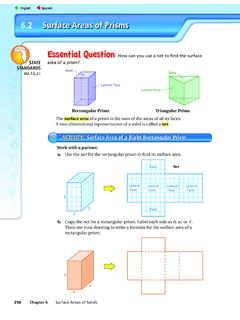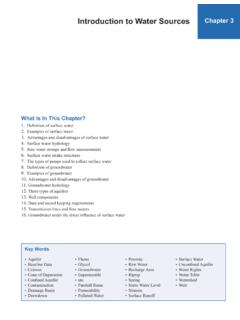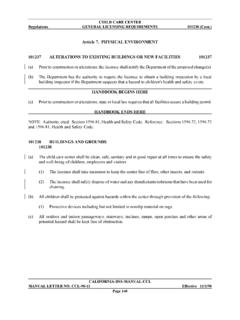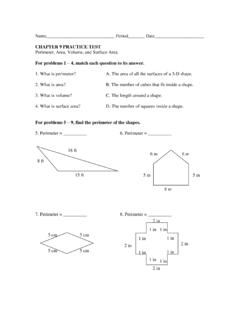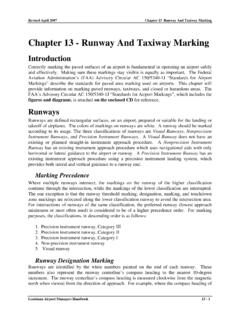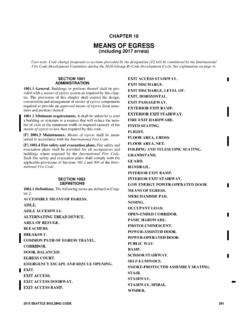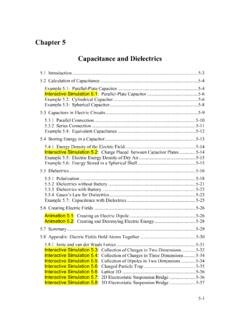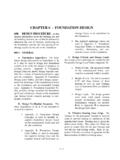Transcription of Ch 12 (26-2-2009)
1 (A) Main Concepts and Results The surface area of an object formed by combining any two of the basic solids,namely, cuboid, cone, cylinder, sphere and hemisphere. The volume of an object formed by combining any two of the basic solidsnamely, cuboid, cone, cylinder, sphere and hemisphere. The formulae involving the frustum of a cone are:(i)Volume of the frustum of the cone = 2212121[]3hrrrr ++(ii)Curved surface area of the frustum of the cone = (r1+r2)l,(iii)Total surface area of the frustum of the solid cone= l(r1+r2)+ 2212 +rr, where 2212( )=+lhrr,h = vertical height of the frustum, l = slant height of the frustum andr1 and r2 are radii of the two bases (ends) of the frustum. Solid hemisphere: If r is the radius of a hemisphere, thencurved surface area = 2 r2total surface area = 3 r2, and volume = 323 r Volume of a spherical shell = ()33124 3rr , where r1 and r2 are respectively itsexternal and internal this chapter , take 227 =, if not stated AREAS AND VOLUMESCHAPTER 1203/05/18 SURFACE AREAS AND VOLUMES137(B)Multiple Choice Questions :Choose the correct answer from the given four options:Sample Question 1 : A funnel (see ) is thecombination of(A) a cone and a cylinder(B) frustum of a cone and a cylinder(C) a hemisphere and a cylinder(D) a hemisphere and a coneSolution : Answer (B)Sample Question 2 : If a marble of radius cm is put into a cylindrical cup full of waterof radius 5cm and height 6 cm, then how much water flows out of the cylindrical cup?
2 (A) cm3(B) cm3(C) cm3(D) cm3 Solution : Answer (A)Sample Question 3 : A cubical ice cream brick of edge 22 cm is to be distributedamong some children by filling ice cream cones of radius 2 cm and height 7 cm upto itsbrim. How many children will get the ice cream cones?(A) 163(B) 263(C) 363(D) 463 Solution : Answer (C)Sample Question 4 : The radii of the ends of a frustum of a cone of height h cm arer1 cm and r2 cm. The volume in cm3 of the frustum of the cone is(A) 2212121[]3hrrrr ++(B) 2212121[ ]3hrrrr +(C) 2212121[ ]3hrrrr +(D) 2212121[ ]3hrrrr Solution : Answer (A)Sample Question 5 : The volume of the largest right circular cone that can be cut outfrom a cube of edge cm is(A) cm3(B) cm3(C) cm3(D) cm3 Solution : Answer (D)03/05/18138 EXEMPLAR PROBLEMSEXERCISE the correct answer from the given four cylindrical pencil sharpened at one edge is the combination of(A) a cone and a cylinder(B) frustum of a cone and a cylinder(C) a hemisphere and a cylinder(D) two surahi is the combination of(A) a sphere and a cylinder(B) a hemisphere and a cylinder(C) two hemispheres(D) a cylinder and a plumbline (sahul) is the combination of (see Fig.)
3 (A) a cone and a cylinder(B) a hemisphere and a cone(C) frustum of a cone and a cylinder(D) sphere and shape of a glass (tumbler) (see Fig. ) is usually in the form of(A) a cone(B) frustum of a cone(C) a cylinder(D) a sphere03/05/18 SURFACE AREAS AND shape of a gilli, in the gilli-danda game (see Fig. ), is a combination of(A) two cylinders(B) a cone and a cylinder(C) two cones and a cylinder(D) two cylinders and a shuttle cock used for playing badminton has the shape of the combination of(A) a cylinder and a sphere(B) a cylinder and a hemisphere(C) a sphere and a cone(D) frustum of a cone and a cone is cut through a plane parallel to its base and then the cone that is formedon one side of that plane is removed. The new part that is left over on the otherside of the plane is called(A) a frustum of a cone(B) cone(C) cylinder(D) hollow cube of internal edge 22cm is filled with spherical marbles of cm and it is assumed that 18 space of the cube remains unfilled.
4 Then thenumber of marbles that the cube can accomodate is(A) 142296(B) 142396(C) 142496(D) metallic spherical shell of internal and external diameters 4 cm and 8 cm, respec-tively is melted and recast into the form a cone of base diameter 8cm. The height ofthe cone is(A) 12cm(B) 14cm(C) 15cm(D) solid piece of iron in the form of a cuboid of dimensions 49cm 33cm 24cm,is moulded to form a solid sphere. The radius of the sphere is(A) 21cm(B) 23cm(C) 25cm(D) mason constructs a wall of dimensions 270cm 300cm 350cm with the brickseach of size and it is assumed that 18 space is03/05/18140 EXEMPLAR PROBLEMS covered by the mortar. Then the number of bricks used to construct the wall is(A) 11100(B) 11200(C) 11000(D) solid spheres of the same size are made by melting a solid metalliccylinder of base diameter 2 cm and height 16 cm.
5 The diameter of eachsphere is(A) 4 cm(B) 3 cm(C) 2 cm(D) 6 radii of the top and bottom of a bucket of slant height 45 cm are 28 cm and7 cm, respectively. The curved surface area of the bucket is(A) 4950 cm2(B) 4951 cm2(C) 4952 cm2(D) 4953 medicine-capsule is in the shape of a cylinder of diameter cm with twohemispheres stuck to each of its ends. The length of entire capsule is 2 cm. Thecapacity of the capsule is(A) cm3(B) cm3(C) cm3(D) two solid hemispheres of same base radius r are joined together along theirbases, then curved surface area of this new solid is(A) 4 r2(B) 6 r2(C) 3 r2(D) 8 right circular cylinder of radius r cm and height h cm (h>2r) just encloses asphere of diameter(A) r cm(B) 2r cm(C) h cm(D) 2h conversion of a solid from one shape to another, the volume of the newshape will(A) increase(B) decrease (C) remain unaltered(D) be diameters of the two circular ends of the bucket are 44 cm and 24 cm.
6 Theheight of the bucket is 35 cm. The capacity of the bucket is(A) litres(B) litres(C) litres(D) a right circular cone, the cross-section made by a plane parallel to the baseis a(A) circle(B) frustum of a cone (C) sphere(D) of two spheres are in the ratio 64:27. The ratio of their surface areas is(A) 3 : 4(B) 4 : 3(C) 9 : 16(D) 16 : 903/05/18 SURFACE AREAS AND VOLUMES141(C) Short Answer Questions with ReasoningWrite True or False and justify your Question 1 : If a solid cone of base radius r and height h is placed over asolid cylinder having same base radius and height as that of the cone, then the curvedsurface area of the shape is 22 rhrrh++.Solution : True. Since the curved surface area taken together is same as the sum ofcurved surface areas measured Question 2 : A spherical steel ball is melted to make eight new identical , the radius of each new ball be 18th the radius of the original : False.
7 Let r be the radius of the original steel ball and r1 be the radius of thenew ball formed after , 33144833 = .rrThis implies r1 = Question 3 : Two identical solid cubes of side a are joined end to end. Thenthe total surface area of the resulting cuboid is : False. The total surface area of a cube having side a is 6a2. If two identicalfaces of side a are joined together, then the total surface area of the cuboid so formedis Question 4 : Total surface area of a lattu (top) as shown in the Fig. isthe sum of total surface area of hemisphere and the total surface area of : False. Total surface area of the lattu is the sum of the curved surfacearea of the hemisphere and curved surface area of the PROBLEMSS ample Question 5 : Actual capacity of a vessel as shown in the Fig. isequal to the difference of volume of the cylinder and volume of the : True.
8 Actual capacity of the vessel is the empty space inside the glass thatcan accomodate something when poured in True or False and justify your answer in the identical solid hemispheres of equal base radius r cm are stuck together alongtheir bases. The total surface area of the combination is 6 solid cylinder of radius r and height h is placed over other cylinder of sameheight and radius. The total surface area of the shape so formed is 4 rh + 4 solid cone of radius r and height h is placed over a solid cylinder having samebase radius and height as that of a cone. The total surface area of the combinedsolid is 22 rrhrh +++ . solid ball is exactly fitted inside the cubical box of side a. The volume of the ballis 34 volume of the frustum of a cone is 2212121 3hrrrr+, where h is verticalheight of the frustum and r1, r2 are the radii of the capacity of a cylindrical vessel with a hemispherical portion raised upward atthe bottom as shown in the Fig.
9 Is []23 23rhr .03/05/18 SURFACE AREAS AND curved surface area of a frustum of a cone is l (r1+r2), where2212()lhrr=++, r1 and r2 are the radii of the two ends of the frustum and h isthe vertical open metallic bucket is in the shape of a frustum of a cone, mounted on ahollow cylindrical base made of the same metallic sheet. The surface area of themetallic sheet used is equal tocurved surface area of frustum of a cone + area of circular base + curved surfacearea of cylinder(C) Short Answer QuestionsSample Question 1 : A cone of maximum size is carved out from a cube of edge14 cm. Find the surface area of the cone and of the remaining solid left out after thecone carved : The cone of maximum size that is carved out from a cube of edge 14 cmwill be of base radius 7 cm and the height 14 area of the cone = rl + r2=222222771477 ++(7)2=()22227245154(1545154)cm15451cm7 +=+=+Surface area of the cube = 6 (14)2 = 6 196 = 1176 cm2So, surface area of the remaining solid left out after the cone is carved out= ()21176 1541545cm+= (1022 + 1545) PROBLEMSS ample Question 2 : A solid metallic sphere of radius cm is melted and recastinto a number of smaller cones, each of radius cm and height 3 cm.
10 Find thenumber of cones so : The volume of the solid metallic sphere = 43 ( )3 cm3 Volume of a cone of radius cm and height 3 cm = 21 3 cm3 Number of cones so formed = 4 31 3 = 126 Sample Question 3 : A canal is 300 cm wide and 120 cm deep. The water in thecanal is flowing with a speed of 20 km/h. How much area will it irrigate in 20 minutesif 8 cm of standing water is desired?Solution : Volume of water flows in the canal in one hour = width of the canal depthof the canal speed of the canal water = 3 20 1000m3 = 20 minutes the volume of water = 337200020m24000m60 =. area irrigated in 20 minutes, if 8 cm, , m standing water is 30 Question 4 : A cone of radius 4 cm is divided into two parts by drawing aplane through the mid point of its axis and parallel to its base.










